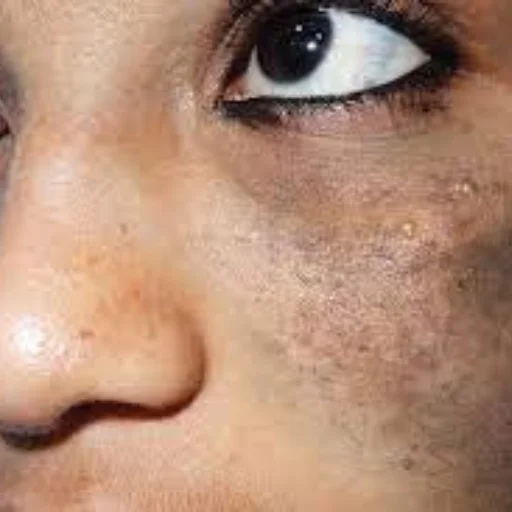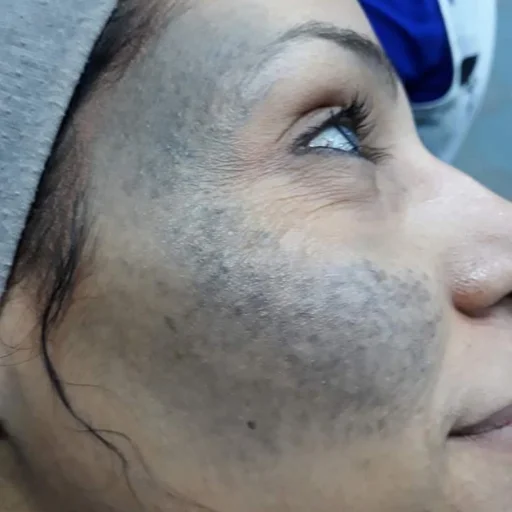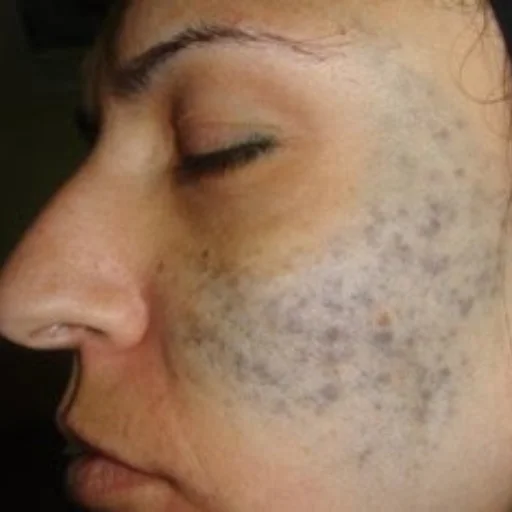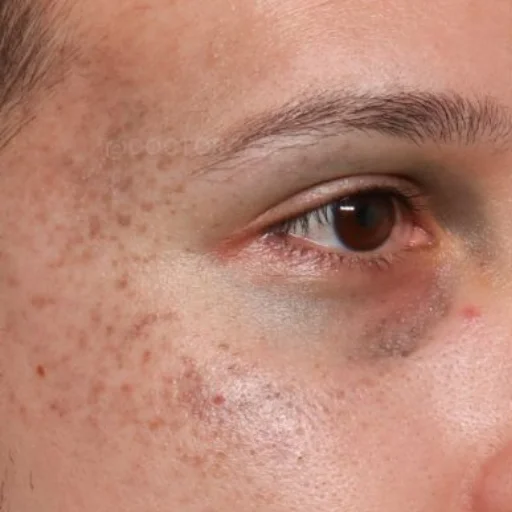Blog
PICO Nd YAG Laser: Effective Treatment for Nevus of Ota

Nevus of Ota, also known as oculodermal melanocytosis, is a benign condition characterized by hyperpigmentation around the eye and sometimes in the eye itself. It appears as a bluish or brownish patch on the skin and can affect the following areas:
- Eye: Sclera (white of the eye), iris (colored part of the eye), conjunctiva (lining of the eyelid)
- Face: Forehead, cheeks, temple, nose, eyelids, upper lip
Causes of nevus of Ota:
The exact cause of nevus of Ota is unknown, but several factors are thought to contribute to its development:
1. Abnormal development of melanocytes:
- During fetal development, pigment-producing cells called melanocytes migrate from the neural crest to the skin.
- In nevus of Ota, these cells become trapped in the upper dermis (layer of skin) instead of reaching their intended location.
- This entrapment leads to the accumulation of melanocytes in the dermis, which causes the characteristic hyperpigmentation.
2. Genetics:
- Nevus of Ota may be associated with certain genetic mutations, although the specific genes involved are not yet fully understood.
- Familial cases of nevus of Ota have been reported, suggesting a genetic predisposition to the condition.
3. Environmental factors:
- Some researchers believe that environmental factors, such as sun exposure, may play a role in the development of nevus of Ota.
- While sun exposure does not directly cause the condition, it may darken the existing pigment patch.
4. Ocular abnormalities:
- Nevus of Ota is sometimes associated with other ocular abnormalities, such as glaucoma or cataracts.
- The exact relationship between these conditions is still being investigated.
It’s important to note that research on the exact causes of nevus of Ota is ongoing. While the factors mentioned above are thought to contribute to the development of the condition, the precise mechanisms are not yet fully understood.




Here are some resources where you can find more information about the causes of nevus of Ota:
- National Institutes of Health: https://eyewiki.aao.org/Oculodermal_Melanocytosis_%28Nevus_of_Ota%29
- MedScape: https://www.medscape.com/viewarticle/451059_5
- WebMD: https://www.webmd.com/skin-problems-and-treatments/what-is-nevus-of-ota
Clinical Features of Nevus of Ota:
Appearance:
- Pigmentation: Bluish, brownish, or grayish patch on the skin.
- Distribution: Usually unilateral, affecting the forehead, temple, cheek, nose, eyelid, or upper lip. May rarely be bilateral.
- Location: Follows the distribution of the ophthalmic and maxillary divisions of the trigeminal nerve (V1 and V2).
- Size: Can be small or large, varying in shape and size.
- Texture: Can be flat or slightly raised.
- Color: May be uniform or have areas of lighter and darker pigment.
- Onset: May be present at birth or develop later in childhood.
Other features:
- Asymptomatic: Most cases are asymptomatic, meaning they do not cause any symptoms.
- Sensory changes: Rare cases may experience sensory changes, such as numbness or tingling, in the affected area.
- Ocular involvement: May be associated with ocular abnormalities, such as glaucoma, cataracts, or pigmentary changes in the iris or conjunctiva.
Clinical differential diagnoses:
- Facial cafe-au-lait patch: A lighter brown patch on the skin, usually not following the trigeminal nerve distribution.
- Spilus nevus: A small, round or oval patch of brown or blue pigmentation.
- Acquired bilateral nevus of Ota-like macules: Bilateral patches resembling nevus of Ota, but not associated with the trigeminal nerve.
Additional features to note:
- Nevus of Ota may darken with sun exposure.
- The appearance of the nevus may change over time, becoming more pronounced or lighter.
- There is no correlation between the size or color of the nevus and the severity of any associated ocular abnormalities.
It is important to note that the signs and symptoms of nevus of Ota can vary considerably between individuals. Some individuals may have a very mild case with only a small, barely noticeable patch on the skin, while others may have a more extensive and noticeable nevus that involves the eye and other areas.
Here are some resources where you can find more information about the signs and symptoms of nevus of Ota:
- National Institutes of Health: https://eyewiki.aao.org/Oculodermal_Melanocytosis_%28Nevus_of_Ota%29
- WebMD: https://www.webmd.com/skin-problems-and-treatments/what-is-nevus-of-ota
- MedScape: https://www.medscape.com/viewarticle/451059_5
Age and Gender Distribution of Nevus of Ota
Age:
- Nevus of Ota can occur at any age, but it is most commonly diagnosed in children and young adults.
- In some cases, nevus of Ota may be present at birth, while others develop it during childhood or adolescence.
- The exact reason for this age distribution is unclear, but it may be related to the timing of melanocyte migration during fetal development.
Gender:
- Nevus of Ota is more common in females than males.
- The estimated ratio of females to males with the condition is approximately 2:1.
- It is unclear why nevus of Ota is more prevalent in females, but hormonal factors may play a role.
Additional factors:
- Ethnicity: Nevus of Ota has a higher prevalence in individuals with Asian or East Asian ancestry.
- Genetics: Some studies suggest that there may be a genetic predisposition to the development of nevus of Ota.
- Family history: Although rare, there have been reported cases of nevus of Ota occurring in families.
It is important to remember that these are general trends and individual cases may vary. Anyone can develop nevus of Ota, regardless of age, gender, ethnicity, or family history.
Here are some resources where you can find more information about the age and gender distribution of nevus of Ota:
- National Institutes of Health: https://eyewiki.aao.org/Oculodermal_Melanocytosis_%28Nevus_of_Ota%29
- WebMD: https://www.webmd.com/skin-problems-and-treatments/what-is-nevus-of-ota
- MedScape: https://www.medscape.com/viewarticle/451059_5
Psychological and Physical Impact of Nevus of Ota
Psychological Impact:
The presence of nevus of Ota can significantly impact a person’s emotional well-being and self-esteem. Here are some potential psychological consequences:
- Low self-esteem: The visible nature of the nevus can lead to feelings of self-consciousness, embarrassment, and shame. This can be particularly challenging for children and adolescents who are already navigating issues of self-image and social acceptance.
- Anxiety and depression: The fear of discrimination, bullying, or rejection can be a significant source of anxiety and depression for individuals with nevus of Ota. This can be exacerbated by the lack of awareness and understanding about the condition in the general population.
- Social isolation: Individuals with nevus of Ota may withdraw from social situations to avoid scrutiny and negative comments. This can lead to feelings of isolation and loneliness.
- Body image concerns: The nevus can be a constant reminder of a perceived physical imperfection, leading to negative body image and dissatisfaction.
- Difficulties with relationships: The presence of nevus of Ota may make it difficult to develop and maintain healthy relationships. This can be due to fear of rejection, communication challenges, or lack of understanding from partners or friends.
Physical Impact:
While nevus of Ota is generally a benign condition, it can still have some physical effects:
- Vision problems: In some cases, the nevus can involve the eye and lead to vision problems, such as glaucoma or cataracts.
- Sensory changes: Rarely, the nevus can cause sensory changes, such as numbness or tingling, in the affected area.
- Skin sensitivity: The skin affected by nevus of Ota may be more sensitive to the sun and other environmental factors.
- Psychological stress: The emotional burden of living with nevus of Ota can manifest as physical symptoms, such as headaches, fatigue, and difficulty sleeping.
- Treatment side effects: Some treatment options for nevus of Ota, such as laser therapy, can have side effects, such as scarring or changes in skin pigmentation.
It is important to note that the impact of nevus of Ota varies greatly from person to person. Some individuals may experience significant psychological and physical effects, while others may have minimal or no impact on their daily lives. The individual’s coping mechanisms, social support system, and access to resources can significantly influence their experience.
Here are some resources that can help individuals cope with the psychological and physical impact of nevus of Ota:
- Nevus Outreach, Inc.: https://www.nevus.org/
- Nevus Network: https://www.nevusnetwork.org/
- National Organization for Rare Disorders (NORD): https://rarediseases.org/
- American Academy of Ophthalmology: https://www.aao.org/
- American Academy of Dermatology: https://www.aad.org/
It is important to seek support from healthcare professionals, mental health professionals, and support groups to help manage the psychological and physical impact of nevus of Ota.
Treatment Options for Nevus of Ota
While there is no cure for nevus of Ota, there are several treatment options available to lighten the appearance of the patch. The best treatment option will vary depending on several factors, including:
- Severity of the nevus: The size, color, and depth of the nevus will influence the choice of treatment.
- Location of the nevus: Some areas, like the eye, require special considerations for treatment.
- Patient’s age and skin type: Younger patients and those with lighter skin tones may respond better to certain treatments.
- Patient’s preferences and expectations: It’s important to discuss the desired outcome and potential risks and benefits of each treatment with the patient.
Here are the most common treatment options for nevus of Ota:
1. Laser therapy:
- Pulsed Q-switched lasers: This is the most effective and widely used treatment for nevus of Ota. Different types of Q-switched lasers, such as Q-switched Nd YAG and Q-switched ruby lasers, are effective in targeting and destroying melanocytes without damaging the surrounding skin.
- Fractional lasers: These lasers create microscopic holes in the skin, stimulating new collagen production and lightening the pigment.
2. Cryotherapy:
- This involves freezing the nevus with liquid nitrogen. Cryotherapy is typically used for smaller nevi and may be combined with other treatments.
3. Dermabrasion:
- This procedure removes the top layers of skin, including the pigment cells. Dermabrasion is typically used for more severe cases and may be combined with other treatments.
4. Microdermabrasion:
- This is a less invasive form of dermabrasion that uses a fine spray of crystals to remove the top layers of skin. Microdermabrasion is a good option for lighter nevi.
5. Chemical peels:
- Certain types of chemical peels, such as glycolic acid or trichloroacetic acid peels, can help lighten the pigment in nevus of Ota.
6. Topical treatments:
- While not as effective as other treatments, topical creams containing hydroquinone or tretinoin may help fade the pigment over time.
7. Camouflage makeup:
- This can be used to help conceal the appearance of the nevus.
It is important to note that some treatment options may have side effects, such as scarring, changes in skin color, or infection. It is crucial to discuss the risks and benefits of each treatment option with a dermatologist or ophthalmologist before making a decision.
Here are some resources for more information on treatment options for nevus of Ota:
- Nevus Outreach, Inc.: https://www.nevus.org/
- American Academy of Dermatology: https://www.aad.org/
- WebMD: https://www.webmd.com/skin-problems-and-treatments/what-is-nevus-of-ota
- MedScape: https://www.medscape.com/viewarticle/451059_5
PICO Nd YAG laser for treatment of Nevus of Ota
The PICO Nd YAG laser is a promising treatment option for Nevus of Ota. It offers several advantages over other lasers, including:
Advantages:
- High efficacy: Several studies have shown that PICO Nd YAG laser is effective in lightening the pigment of Nevus of Ota, with reported clearance rates of up to 70%.
- Improved safety: The PICO Nd YAG laser uses picosecond pulses, which are much shorter than traditional Q-switched lasers. This minimizes the risk of side effects, such as scarring and hypopigmentation.
- Greater versatility: The PICO Nd YAG laser has multiple wavelengths (1064nm, 755nm, and 532nm), making it suitable for treating different depths and types of pigment.
- Faster treatment times: PICO Nd YAG laser treatments are typically shorter than those with traditional lasers, making them more convenient for patients.
- Reduced pain: PICO Nd YAG laser treatments are generally less painful than other laser treatments.
Specific benefits of each wavelength:
- 1064nm: This wavelength targets deeper melanin deposits and is effective for treating the dermal component of Nevus of Ota.
- 755nm: This wavelength targets shallower melanin deposits and is effective for treating the epidermal component of Nevus of Ota.
- 532nm: This wavelength targets melanin and blood vessels, making it effective for treating vascular components of Nevus of Ota that may contribute to the discoloration.
Comparison to other lasers:
- Q-switched Nd YAG laser: This is the traditional laser used for treating Nevus of Ota. It is effective but has a higher risk of side effects than the PICO Nd YAG laser.
- Alexandrite laser: This laser can also be used for treating Nevus of Ota, but it is less effective than the PICO Nd YAG laser.
Overall, the PICO Nd YAG laser is a safe and effective treatment option for Nevus of Ota. It offers several advantages over other lasers, making it a promising choice for patients with this condition.
Here are some resources for further information:
- Treatment of nevus of Ota with 1064 nm picosecond Nd YAG laser: A retrospective study: https://pubmed.ncbi.nlm.nih.gov/34609042/
- Successful Treatment of Ota Nevus With the 532-nm Solid-State Picosecond Laser: https://www.mdedge.com/dermatology/article/134254/pigmentation-disorders/successful-treatment-ota-nevus-532-nm-solid-state
- Our perspective of the treatment of naevus of Ota with 1,064-, 755- and 532-nm wavelength lasers: https://pubmed.ncbi.nlm.nih.gov/28398430/
It is important to note that this information is not a substitute for professional medical advice. Please consult with a dermatologist or ophthalmologist to discuss whether PICO Nd YAG laser treatment is right for you.
Sessions and Outcomes of PICO Nd YAG Laser Treatment for Nevus of Ota
Number of sessions:
The number of sessions required for PICO Nd YAG laser treatment for Nevus of Ota varies depending on several factors, including:
- Severity of the nevus: More extensive or darker nevi may require more sessions than lighter or smaller ones.
- Depth of the pigment: Deeper pigment may require more sessions to be effectively targeted.
- Patient’s skin type and response to treatment: Some individuals may respond better to treatment than others, requiring fewer sessions.
- Desired outcome: Patients with higher expectations for pigment removal may require additional sessions.
Generally, most patients require 3-6 sessions to achieve significant improvement. However, in some cases, up to 10 sessions or more may be needed. Each session is typically spaced 4-6 weeks apart to allow the skin to heal and for the full effect of the previous treatment to become apparent.
Outcomes:
PICO Nd YAG laser treatment is considered highly effective for treating Nevus of Ota. Studies have shown that it can achieve pigment clearance rates of up to 70%, with noticeable improvement in skin tone and appearance.
Here’s what you can expect after treatment:
- Gradual lightening of the pigment: The pigment will fade gradually over the course of several weeks and months.
- Improved skin tone and texture: The treated area will appear smoother and more even-toned.
- Reduced appearance of the nevus: The nevus may become less noticeable or even disappear completely.
- Long-lasting results: The results of PICO Nd YAG laser treatment are generally long-lasting, although some individuals may experience some return of pigment over time.
However, it’s important to note that some individuals may not experience complete pigment removal, and the results may vary. It is important to discuss your realistic expectations for the outcome with your dermatologist before undergoing treatment.
Here are some resources where you can find more information about the outcomes of PICO Nd YAG laser treatment for Nevus of Ota:
- Treatment of nevus of Ota with 1064 nm picosecond Nd:YAG laser: A retrospective study: https://pubmed.ncbi.nlm.nih.gov/34609042/: https://pubmed.ncbi.nlm.nih.gov/34609042/
- Successful Treatment of Ota Nevus With the 532-nm Solid-State Picosecond Laser: https://www.mdedge.com/dermatology/article/134254/pigmentation-disorders/successful-treatment-ota-nevus-532-nm-solid-state: https://www.mdedge.com/dermatology/article/134254/pigmentation-disorders/successful-treatment-ota-nevus-532-nm-solid-state
- Our perspective of the treatment of naevus of Ota with 1,064-, 755- and 532-nm wavelength lasers: https://pubmed.ncbi.nlm.nih.gov/28398430/: https://pubmed.ncbi.nlm.nih.gov/28398430/
Remember to consult a qualified dermatologist for personalized advice and guidance regarding PICO Nd YAG laser treatment for Nevus of Ota.
Pre-care and Post-care for PICO Nd YAG Laser Treatment for Nevus of Ota
Pre-care:
To prepare for your PICO Nd YAG laser treatment for Nevus of Ota, your dermatologist may recommend the following:
1. Avoid sun exposure: Minimize sun exposure for several weeks before your treatment. This will help prevent hyperpigmentation and increase the effectiveness of the treatment.
2. Discontinue certain medications: Inform your dermatologist about any medications or supplements you are taking. They may advise you to stop taking certain medications that can increase your risk of bleeding or sun sensitivity.
3. Avoid smoking and alcohol: Abstain from smoking and alcohol for at least a week before your treatment, as they can impair healing.
4. Remove makeup and skincare products: Ensure your face is clean and free of makeup and skincare products before your treatment.
5. Discuss your expectations and concerns: Talk to your dermatologist about your desired outcome and any concerns you have about the treatment.
Post-care:
Following your PICO Nd YAG laser treatment, your dermatologist will provide you with specific instructions for post-care. Here are some general guidelines:
1. Apply ice packs: Use ice packs to reduce swelling and discomfort. Apply them for 15-minute intervals several times a day.
2. Use gentle cleansers and moisturizers: Wash the treated area with gentle cleansers and apply fragrance-free moisturizers as recommended by your dermatologist.
3. Avoid sun exposure: Continue to avoid sun exposure for several weeks after your treatment and use sunscreen with SPF 30 or higher every day.
4. Avoid picking or scratching the treated area: Don’t pick or scratch the treated area, as this can increase the risk of scarring.
5. Avoid harsh treatments: Avoid using harsh soaps, scrubs, or other exfoliating products on the treated area.
6. Wear loose clothing: Wear loose clothing that doesn’t irritate the treated area.
7. Attend follow-up appointments: Attend all follow-up appointments with your dermatologist to monitor your progress and address any concerns.
Here are some additional resources that you may find helpful:
- Nevus Outreach: https://www.nevus.org/
- American Academy of Dermatology: https://www.aad.org/
- National Library of Medicine: https://www.medscape.com/viewarticle/451059_7
Remember, everyone heals differently, and your post-care experience may vary. Always consult your dermatologist if you have any questions or concerns about your recovery.
PICO Nd YAG Laser Treatment for Nevus of Ota at Derma & Dental Clinic
Derma & Dental Clinic offers PICO Nd YAG laser treatment for Nevus of Ota, a safe and effective option with several advantages:
- High efficacy: Up to 70% clearance rate for pigment lightening, achieved through expertise of our esteemed team of dermatologists.
- Improved safety: Picosecond pulses minimize side effects like scarring and hypopigmentation due to the advanced technology and precise application by our experienced doctors.
- Greater versatility: Multiple wavelengths (1064nm, 755nm, and 532nm) target different depths and types of pigment expertly assessed and treated by our qualified dermatologists.
- Faster treatment times: Convenient for patients compared to traditional lasers thanks to the efficiency of our treatment protocols.
- Reduced pain: Generally less painful than other laser treatments due to the gentler nature of the PICO Nd:YAG laser and the skillful application by our dermatologists.
Our team of esteemed dermatologists are highly experienced and qualified in PICO Nd YAG laser treatment for Nevus of Ota, ensuring you receive the highest quality care and optimal results.
Here are some of the benefits of choosing Derma & Dental Clinic for your PICO Nd YAG laser treatment:
- Experienced and qualified dermatologists: Our team has extensive experience and expertise in using PICO Nd YAG lasers for Nevus of Ota.
- Advanced technology: We use the latest technology to ensure safe and effective treatment.
- Personalized treatment plans: We will create a personalized treatment plan based on your individual needs.
- Comfortable and inviting environment: We offer a comfortable and inviting environment to help you relax during your treatment.
- Convenient scheduling: We offer flexible scheduling options to accommodate your busy schedule.
Contact us today to schedule your consultation and learn more about how PICO Nd YAG laser treatment can help you achieve a clearer and more even skin tone.
Website: Visit Dermatology.pk to find detailed information about our services, browse our gallery, and schedule your consultation with ease.
WhatsApp: Reach us directly on WhatsApp at +923205999650 for immediate assistance.
UAN: Dial 03041115000 to connect with our scheduling team and book your appointment.
Derma & Dental Clinic Bahria Town Lahore is committed to providing you with the highest quality care and helping you achieve your desired results. Contact us today to begin your journey towards a healthier, more confident you.
Categories
- Accessoreis
- Acne
- Aesthetic Procedures
- Anti Aging
- Author
- Baby Care
- Beauty
- Beauty & Cosmetics
- Blog
- Body Care
- cosmetic procedures
- Dandruff
- Dental Bonding
- Dental Care
- Dental Fillings
- Dental Health
- Dermatologist
- Dermatology
- Doctor
- Downloads
- Eye Care
- Food
- Food and Nutrition
- Hair Care
- Hair Loss Treatment
- Haircare
- Hand and foot care
- Health
- Health and Wellness
- Healthcare
- Imported Products
- Kids and baby care
- Laser Hair Removal
- Lip Care
- Medication
- Men's skin care
- Men's Skincare
- Nail Care
- Nutrition
- Oily Skin
- Online Consultation
- Oral Health
- Personal Care
- Pharmaceuticals
- Procedures
- Products and Ingredients
- scalp care
- Science
- Self care and wellness
- Shampoo
- Skin and Scalp Conditions
- Skin Care
- Skin Care and lifestyle
- Skin care myths and facts
- Skin Treatment
- Skincare
- skincare products
- Smile Design
- sunblocks
- Teeth Whitening
- wellness
- Whitening and brightening














